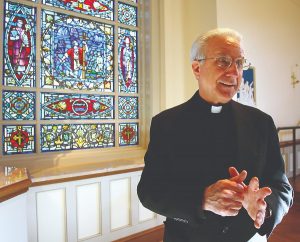On a recent sunny afternoon, the stained glass windows at St. Louis in Clarksville sparkled with a radiance few could have imagined when they stood in their original home at the Basilica of the National Shrine of the Assumption of the Blessed Virgin Mary in Baltimore.
Illuminated by the mid-day sun, brilliant shades of cobalt blue, deep purples and fiery reds seemed to leap from the glass and command a visitor’s gaze.
The nine major windows, eight of which are 14 feet tall, were removed from the basilica and installed inside the new St. Louis church, which Cardinal William H. Keeler dedicated in April.
The stained glass windows were replaced at the basilica with plain ones when the historic church was restored to the vision of Benjamin Henry Latrobe and Archbishop John Carroll. Both had sought a worship space flooded with natural light symbolic of religious freedom.
Monsignor Joseph Luca, St. Louis pastor, said he couldn’t be more pleased that Cardinal Keeler agreed to permanently loan the windows to his parish.
The new church was designed around the windows, he said, which gives them the best possible display.
“I think it’s been a win-win for everyone,” said Monsignor Luca, noting that the windows had previously been “forced into a space (at the basilica) in an architectural design that did not intend stained glass windows.”
The basilica now “just sparkles and shines” without them, he said, while St. Louis benefits from showing their artistry in a literal new light.
“The windows are very ornate and are artistically very busy,” said Monsignor Luca. “By having the plain walls (at St. Louis) to contrast with them, it really allows them to stand out and allows the windows to tell the story they intended to tell.”
Each window includes an upper section depicting events of the Old Testament, a middle section depicting events in the life of Christ and a lower section with events in the history of the Church in America.
They are displayed in pairs, with semi-gothic arches placed above them.
Four new rose windows in the style of the basilica windows were created by William Miles of Artisan Glass Studios of Baltimore for the church transepts.
Eighteen smaller basilica windows also decorate the narthex, and two additional pair of basilica-style windows have been commissioned – one showing scenes from the life of St. Louis and the other highlighting the history of the parish.
The original windows were designed by Conrad Schmidt Studios and added to the basilica in the 1940s.
David Walsh, a St. Louis parishioner whose family had donated a stained glass window to the basilica in memory of his great-great grandfather, Joseph Nelligan, said he couldn’t be happier with the look of the windows in their new home.
“They’re gorgeous,” he said. “Especially in the late afternoon, when the sun is really working its magic, they’re just spectacular.”
Monsignor Luca said it is appropriate for the windows to be at St. Louis. His parish was the home of Charles Carroll of Carrollton, the only Roman Catholic signer of the Declaration of Independence and a cousin of Archbishop Carroll.
St. Louis parishioners are equally thrilled, according to the pastor, and when 100 priests attended the church’s dedication, virtually all of them raved about the relocated windows.
“Many of them had emotional connections to the basilica because they were ordained there or were seminarians who were accustomed to going to the basilica for weekly prayer,” he said. “So I thought that was the highest compliment of all.”
Mark Potter, executive director of the Basilica Historic Trust, said he was among those who were hesitant about removing the windows from the basilica. But after seeing how the widows sparkle at St. Louis and how the restored basilica is bathed in natural light from the restored skylights and the plain glass windows, he said it was “absolutely the right thing to do.”
Email George Matysek at gmatysek@CatholicReview.org
Copyright © 2006 Catholic Review Media
